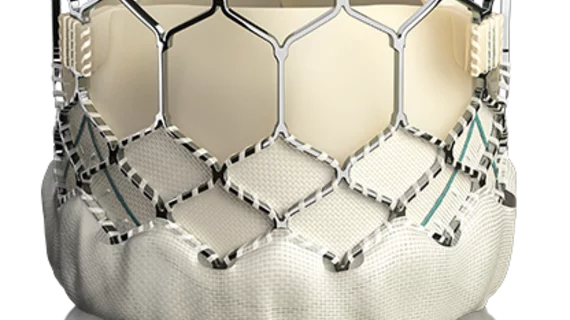Among nearly 1,600 patients receiving a SAPIEN 3 transcatheter heart valve (THV), 3.5 percent experienced at least moderate paravalvular regurgitation (PVR) at 30 days and were 2.4 times more likely to die within one year, according to an analysis published in JAMA Cardiology.
The mortality risk associated with moderate to severe PVR was consistent with previous studies, wrote lead author Phillippe Pibarot, DVM, PhD, and colleagues, but the rate of moderate or worse PVR dropped threefold when compared to previous SAPIEN valves. The SAPIEN valves are developed by Edwards Lifesciences, which funded the study and attempted to reduce PVR from transcatheter aortic valve replacement (TAVR) with its third-generation SAPIEN 3 product.
“Given that patients with at least moderate PVR at 30 days harbor a 2.4-fold increase in 1-year mortality and that it is difficult to predict who among the survivors will exhibit a regression of PVR, it is essential to make every effort to avoid at least moderate PVR at the time of TAVR,” Pibarot and co-authors wrote. “This effort includes comprehensive periprocedural imaging to assess the presence and severity of PVR as well as the use of corrective procedures (i.e., balloon postdilation) if at least moderate PVR is present.”
Pibarot et al.’s secondary analysis of the PARTNER II SAPIEN 3 trial included 1,592 patients with severe, symptomatic aortic stenosis who were considered to be at intermediate or high surgical risk. Transthoracic echocardiograms (TTEs) were used to categorize PVR on a five-point scale: 0, none or trace; 1, mild; 2, mild to moderate; 3, moderate; 4, moderate to severe; and 5, severe. The researchers noted the five-class scheme could be easily collapsed into the three-class scheme (mild, moderate, severe) recommended by the American Society of Echocardiography guidelines.
Among their findings:
- 55.7 percent of patients had none-trace PVR, 32.6 percent had mild, 8.2 percent had mild to moderate and 3.5 percent had at least moderate PVR at 30 days.
- 9.3 percent of patients died within one year and 14.2 percent had been rehospitalized.
- Only patients with at least moderate PVR had significantly higher one-year rates of all-cause mortality (2.4-fold), cardiovascular mortality (2.68-fold) and rehospitalization (2.27-fold) when measured against none-trace PVR.
- Among patients with at least moderate PVR at 30 days who also had a TTE available at one year, 73 percent experienced at least a one-class reduction in PVR severity.
- Patients with mild to moderate PVR were 6.8 times more likely to require valve reintervention and patients with at least moderate PVR were 13 times more likely to require valve reintervention compared with none-trace PVR. However, people experiencing mild PVR weren’t significantly more likely to require valve reintervention.
“Given that mild PVR is frequent, even with the new generations of THVs, and that previous studies yielded to conflicting results with regards to its effect on outcomes, these findings provide important new insights and have major clinical implications,” Pibarot et al. wrote.
Pibarot and colleagues noted inconsistent imaging may account for some differences in PVR grades between the 30-day and one-year results. In addition, the data on PVR regression was based on a small subset of patients.

